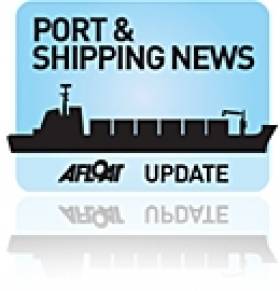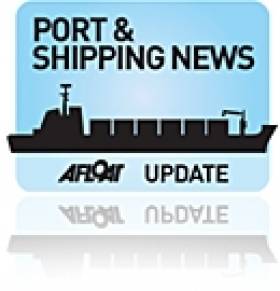Displaying items by tag: Grimaldi Lines
Looking to Build at Port of Cork, As 6,000 Car Storage Facility Is Explored Amid Surge in Imports
The possibility of building at the Port of Cork, a vast 6,000-space multi-storey storage compound for new cars imports is been explored, after it had to cope with a 60% surge in new cars that led to opening a new 'temporary' facility.
Typically, the port writes the Irish Examiner, receives approximately 5,000 trade cars at its Ringaskiddy (DWT) Deepwater Terminal in lower Cork Harbour in January, is expecting the arrival of more new vehicles estimated to be 8,000. The terminal Afloat adds is opposite of the berth for Brittany Ferries route to France which adjoins the Cork Container Terminal (CCT) which opened in 2022.
Existing infrastructure to store cars is at a facility also in Ringaskiddy which has reached capacity, however this has led to a port company decision to allocate a new storage facility for cars at Paddy’s Point, for the first time.
Paddy’s Point is located to the east of Ringaskiddy village, close to University College Cork’s Beaufort Research Laboratory which neighbours the campus of the National Maritime College of Ireland (NMCI).
According to the port which said today, “This temporary expansion is required to ensure the smooth and efficient handling of this substantial shipment”
At the weekend, the Port of Cork handled almost 3,000 cars, having arrived on two vehicle carrying-vessels from the Italian operator, Grimaldi Group, which Afloat reported of their separate Zeebrugge-Antwerp-Cork ro-ro freight feeder route launched in 2021 avoiding the UK land-bridge.
As for the combined vehicles on board, they ranged of Audi, Cupra, Seat, Skoda and Volkswagen models. Several companies are involved in importing to Cork, including OGMA, Euromed Ireland Logistics Ltd, National Vehicle Distribution, Mainport and the Doyle Shipping Group.
More from newspaper on the expansion of the vehicle trade sector.
#GrandeShip - Almost 57,000 tonnes, the impressive Grande Atlantico (as pictured), a vehicle-carrier fresh from dry-docking in the UK, remains anchored in Dublin Bay offshore of the popular Forty Foot bathing place, writes Jehan Ashmore.
Since her arrival last weekend, the multipurpose ro-ro vessel capable of handling 3,515 cars and more than 1,300 containers had been in drydock for a period of one month having undergone maintenance at A&P Falmouth, Cornwall.
Grande Atlantrico measures 214m length X 32m beam X 9.6m draught. She is a 'Grande Class 1' series vessel operated by Italian shipping giant, Grimaldi Lines. The Naples based group, has one of the world's largest fleet of ro-ro, combination ro-ro's carriers in addition to operating ferries in the Mediterranean.
Having anchored less than 2 nautical miles offshore of Sandycove, the appearance of the 1999 built vessel is an unusual sight in Dublin Bay, as normally she and her fleetmates are scheduled to make arrival and departures into Dublin Port during night-time operations.
She is to berth in the port this evening at Alexandra Basin west from where her large stern door will be lowered onto the quayside so to discharge and take on board cargo.
The Gibraltar registered Grande Atlantico operates the 'Grimaldi Central Express Service' which involves calling to Hamburg, Germany and Antwerp Belgium and ports in the following West African countries, Benin, Togo, Nigeria and Ghana.
Following her Dublin departure around midnight, Grande Atlantico is scheduled to reach her final port of call, Tema in Ghana in mid-September.
Grimaldi Lines only began operations to Dublin in 2012, though the shipping company's distinctive yellow hulled ships have been serving Cork Harbour for many years using Ringaskiddy's deepwater berth.
Italians Bring Home Irish Military Equipment from Africa
On Monday 26 July, the Grande Senegal, a brand new vessel that was only launched this year for Italian shipping giant, Grimaldi Lines, docked in Dublin after a 9,600km voyage from Douala, Cameroon, along Africa's mid-western coast.
Onboard was a large-scale consignment of Irish Defence Forces military equipment from Chad, writes Jehan Ashmore.
The charter of the 47,218 gross tonnes marked the final phase in the withdrawel since April of Irish Defence Forces from UN-peacekeeping duties in the troubled land-locked central African state. The Irish-based troops had already flown home in advance of the military hardware.
In total, 3,000 tonnes of equipment was shipped which included 208 TEU (20-foot long containers) 75 trucks, 4x4s, armoured vehicles and an assortment of trailers and fuel bowsers.
The cargo was first moved from Defence Force facilities based at Goz Beida, in eastern Chad, across 900km of desert to the Chadian capital, N'Djamena. From there the equipment was divided with sensitive cargo flown to the port of Douala. The remaining cargo was taken on another 900km road-trip to Ngaoundere, in northern Cameroon. Upon arrival at Ngaoundere, the cargo was transferred by rail for 650km to Douala, finally completing the journey to the African port.
The transportation was undertaken during the impending threat of the rainy season which can pose serious difficulties for all modes of
wheeled transport to the extent that renders progress to be difficult if not impossible. The major logisticical exercise was one of the most
challenging operations experienced by the Defence Forces.
With the equipment loaded at Douala, Grande Senegal set sail on 13 July bound for Dublin. The long-distance passage took a fortnight to arrive at Dublin, where the ConRo (Containers and Roll-On Roll-Off) vessel discharged vehicles through the stern-mounted door ramp.
Once the equipment was disembarked at the quayside, the Gardai and Defence Forces provided joint escorts to the vehicle-conveys, to ensure a speedy exit out of the port, destined for military barracks. Grande Senegal is one of seven Grande 'Angola' class newbuilds built at the Uljanik Shipyard, Pula, Croatia. Each 210 metre-long ConRo vessel can combine a load of 2000 vehicles and 800 TEU, or alternatively a maximum of 1,360 TEU. The Grande Senegal departed Dublin the next day for Amsterdam.































































